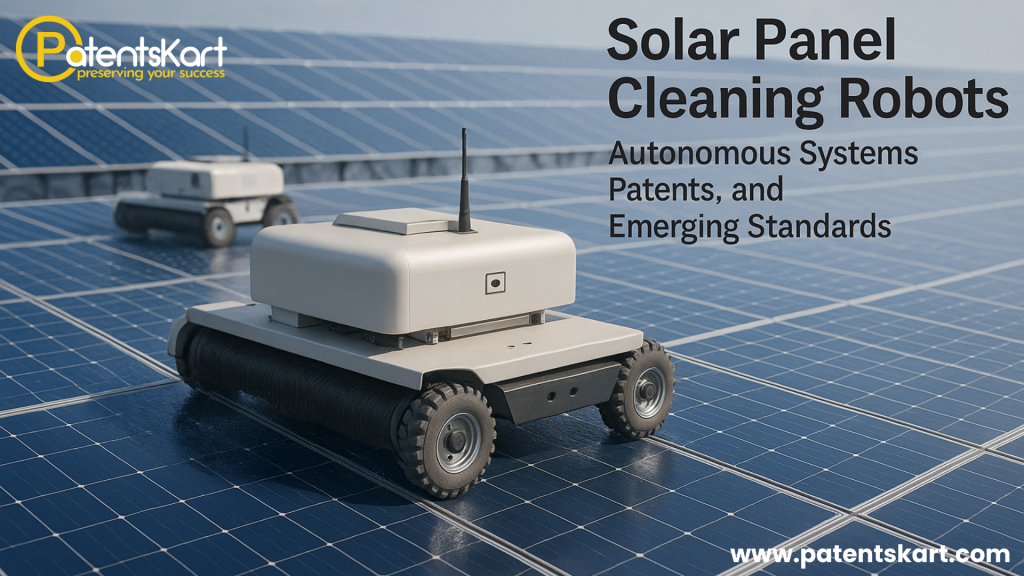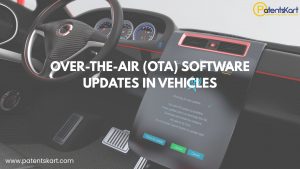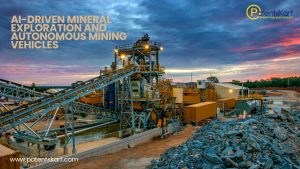Introduction – Why are solar panel cleaning robots becoming essential?
Solar power is one of the fastest-growing renewable energy sources worldwide. Yet, there’s a silent challenge threatening its efficiency: dust, dirt, and pollution. Studies show that solar panels can lose up to 30% of their efficiency when left uncleaned for long periods. Traditional cleaning methods—manual labor, water-based washing, or semi-automated systems—are no longer sufficient for today’s massive solar farms.
This is where solar panel cleaning robots come in. These autonomous systems reduce water usage, minimize labor costs, and ensure panels operate at peak efficiency year-round. More importantly, they are reshaping the solar O&M (operations and maintenance) industry, with strong implications for investors, technology developers, and IP stakeholders.
What are solar panel cleaning robots and how do they work?
Solar panel cleaning robots are autonomous or semi-autonomous machines designed to remove dust, sand, bird droppings, and other pollutants from solar panels without manual intervention. They typically use:
- Dry cleaning robots – Equipped with brushes, microfiber rollers, or air jets; ideal for arid regions with water scarcity.
- Wet cleaning robots – Use water or biodegradable cleaning fluids; more common in industrial zones with sticky pollutants.
- Hybrid robots – Combine dry and wet cleaning for versatile use.
- AI-powered robots – Equipped with sensors and vision systems to detect dust levels and schedule cleaning intelligently.
- IoT-enabled robots – Provide remote monitoring and fleet management, especially for utility-scale solar farms.
By reducing reliance on manual labor and water-intensive cleaning, robotic solar cleaning technology offers a sustainable path forward.
Where are solar panel cleaning robots being applied today?
Applications of solar panel cleaning robots are expanding across different solar segments:
- Utility-scale solar farms – Robots are most commonly used here, covering hundreds of megawatts with precision and speed.
- Commercial rooftops – Adoption is increasing in polluted urban areas where manual cleaning is costly and inconsistent.
- Residential solar panels – Still a niche market due to high upfront costs, but compact robots are emerging.
- Agri-PV (agricultural solar installations) – Robots prevent dust and soil accumulation, ensuring consistent farm-based solar output.
As solar deployment spreads globally, robotic cleaning solutions are evolving to meet diverse environments and installation types.
What is the technology readiness of solar panel cleaning robots?
The development of solar cleaning robots can be tracked through Technology Readiness Levels (TRLs):
- Dry cleaning robots (TRL 7–9): Already commercialized and widely used, especially in desert regions like the Middle East and India.
- Wet cleaning robots (TRL 5–7): Proven and available, but adoption is limited due to water concerns.
- Hybrid and AI-enabled robots (TRL 3–5): Still in the early adoption stage but attracting strong R&D interest due to efficiency potential.
This maturity curve shows that while dry-cleaning robots dominate today, AI-powered solar panel cleaning robots will likely lead future innovation.
What are the latest innovations in solar panel cleaning robots?
The industry is experiencing rapid R&D breakthroughs, including:
- Self-powered robots – Equipped with mini solar panels to recharge themselves.
- AI-driven dust detection – Robots clean only when required, reducing unnecessary cycles.
- IoT-based fleet management – Enables centralized monitoring of multiple robots across solar farms.
- Waterless electrostatic cleaning – An emerging technology that eliminates the need for water.
- Eco-friendly cleaning fluids – Designed for sustainable wet-cleaning systems.
These innovations are not only improving efficiency but also creating new opportunities for intellectual property and patent filings.
How big is the global market for solar panel cleaning robots?
The global solar panel cleaning robot market is projected to grow at a CAGR of 15–18% between 2024 and 2030, more than doubling its current size.
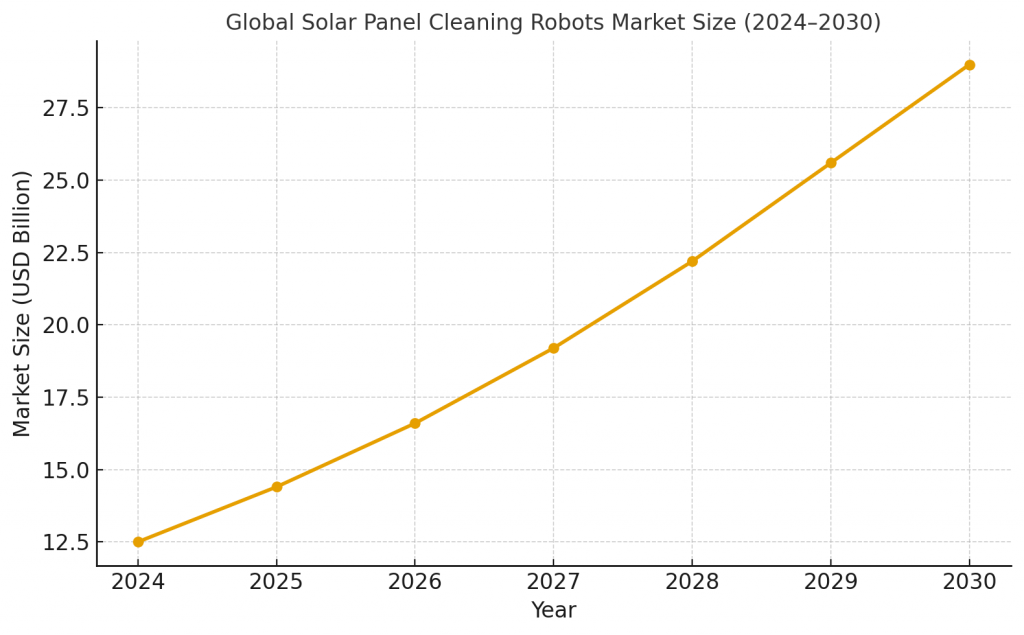
Key growth drivers include:
- Rising global solar PV installations.
- Increasing water scarcity (boosting demand for dry-cleaning robots).
- Labor shortages in large solar projects.
- Push for automated O&M solutions to reduce costs.
Leading regions for adoption:
- Middle East: High dust levels and water scarcity.
- India: Government-backed solar expansion and O&M challenges.
- China: State-supported deployment in massive solar parks.
- USA & Europe: Adoption driven by ESG goals and labor costs.
The outlook is clear: solar panel cleaning robots are transitioning from a niche solution to a mainstream necessity.
What does the patent landscape reveal about solar panel cleaning robots?
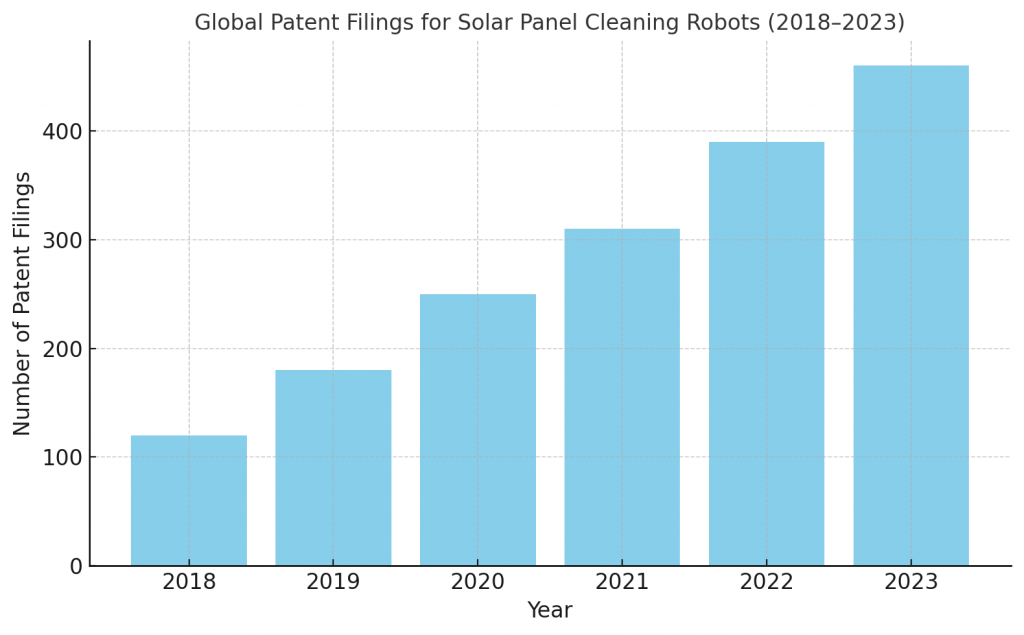
Patent activity is one of the strongest indicators of innovation in this sector. Since 2018, there has been a sharp rise in global patent filings related to robotic solar cleaning technology.
Top innovation areas include:
- Dust removal mechanisms and brush designs.
- Rail-less, modular navigation systems.
- AI-driven monitoring and predictive maintenance.
- Solar-powered, self-sufficient cleaning robots.
Leading patent holders: Ecoppia, Airtouch Solar, and several Chinese research institutes.
For IP stakeholders, this is a sign that competition is heating up—and that identifying white spaces will be critical for long-term success.
Who are the leading companies and startups in this space?
The global market for autonomous solar panel cleaning robots is shaped by a strong mix of established corporations and agile startups. Major industry players such as Ecoppia, Solar Cleano, Sunpuretech, Kaercher, Airtouch Solar, Jetson Robotics, Aegeus Technologies, Hycleaner, Serbot, Bladeranger, Wash Panel, AX Solar Robot, and Miraikikai are leading innovation through large-scale deployments and turnkey robotic cleaning systems. These companies dominate commercial and utility-scale markets, offering a range of technologies spanning wet cleaning, dry cleaning, and hybrid cleaning solutions. For instance, Ecoppia and Kaercher have become global benchmarks in waterless and high-pressure wet cleaning respectively, while Airtouch Solar and Jetson Robotics have advanced dry-cleaning mechanisms optimized for desert and remote solar farms. Similarly, Aegeus Technologies and Hycleaner are contributing to efficient automation and durable robot design, enabling performance across varied terrains and climatic conditions.
In the wet-cleaning segment, key contributors like Ecoppia, Kaercher, Hycleaner, AX Solar Robot, Radiant, Darbco, Arc Tech, Fenice Energy, and Alion Energy are refining water-assisted and hybrid cleaning techniques that ensure minimal residue and greater efficiency for large photovoltaic installations. Conversely, the dry-cleaning segment is driven by companies such as Solar Cleano, Airtouch Solar, Jetson Robotics, Aegeus Technologies, Bladeranger, Taypro, Miraikikai, and Hekabot, who have pioneered waterless cleaning innovations tailored for arid environments. The hybrid cleaning domain, which merges the advantages of both methods, is led by Skilancer Solar, INTEGRA GLOBAL, PlasmaBerry, and Radiant, focusing on adaptive designs and intelligent cleaning algorithms for diverse soiling conditions. These mature organizations form the technological backbone of autonomous solar cleaning, contributing to high TRL (Technology Readiness Level) and steady commercial adoption worldwide.
Alongside these established firms, a wave of innovative startups is reshaping the industry’s trajectory through novel ideas and scalable designs. Emerging companies such as Solavio, Solabot, Solar Drone, Renu Robotics, Greenleap Robotics, Inforbob, Solbright, Skilancer Solar, Taypro, NOMADD, Vayu Solar, and Premium Motion are bringing flexibility and affordability to the solar O&M (operations and maintenance) market. Solavio, Solar Drone, and Skilancer Solar are recognized for their hybrid cleaning systems, integrating intelligent controls with minimal water usage, ideal for utility-scale farms. Meanwhile, startups like Solabot, Renu Robotics, and Greenleap Robotics have revolutionized dry-cleaning solutions with advanced brush systems, lightweight mobility, and autonomous navigation, designed especially for dust-prone and off-grid solar installations. These firms are vital in bridging the affordability gap, offering modular and scalable robotic solutions that suit residential, industrial, and large commercial projects alike.
The industry is also supported by a network of research institutions and university partnerships that fuel continuous improvement. Academic leaders such as Harvard University, MIT, Stanford University, University of Luxembourg, and Hong Kong University are developing innovative prototypes in wireless control, electrostatic cleaning, and AI-based navigation systems. This academic involvement has directly influenced startups and major corporations alike, fostering advancements in waterless technology, self-diagnosing robots, and predictive maintenance algorithms that define next-generation solar cleaning systems.
Collaboration remains a defining feature of the sector, with numerous consortia and partnerships accelerating deployment and market access. Notable alliances include Infosys & Kaynes Group for the Kleinbot platform, Ecoppia & Fortum for large-scale autonomous cleaning across India, Airtouch Solar & ReNew Power for water-free robotic installations, and Sunpure & Cleanmax for sustainable solar O&M solutions. Similarly, partnerships such as Jetsons Robotics & Powermat and RIMA (Robotics for Inspection and Maintenance) reflect the industry’s cross-disciplinary synergy, merging robotics, AI, and renewable energy expertise.
How are different regions adopting solar panel cleaning robots?
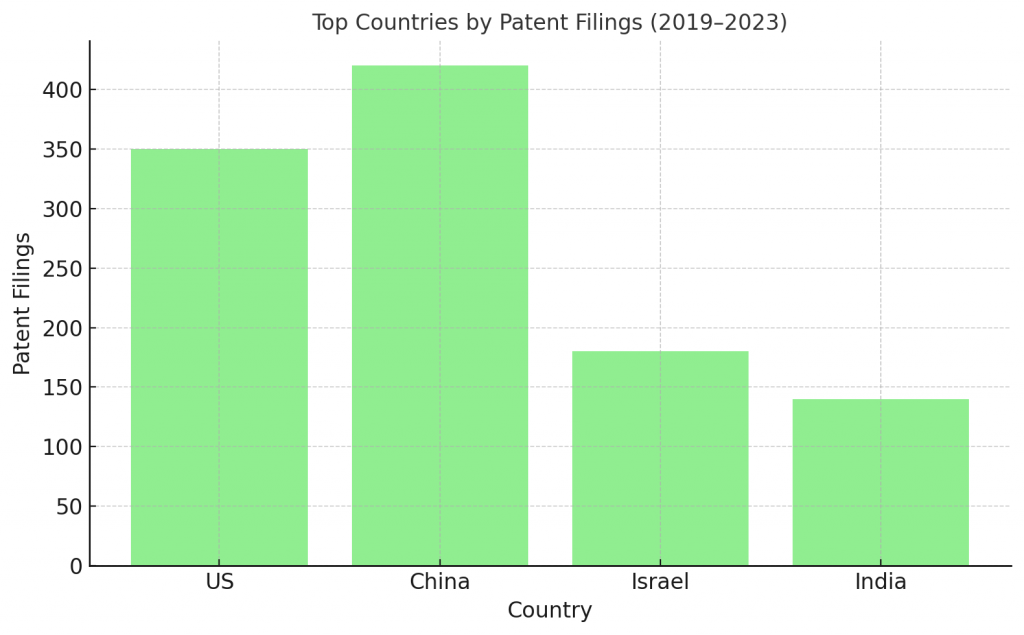
- Middle East (UAE, Saudi Arabia): Early adopters, driven by desert dust and water scarcity.
- India: Rapid uptake in large-scale farms owned by NTPC, Adani, and others.
- China: Government-driven adoption across mega solar parks.
- USA & Europe: Focused on sustainability and automation due to labor shortages.
- Japan: Developing compact robots for rooftop solar panels due to space limitations.
These case studies highlight that adoption patterns depend heavily on geography, dust levels, and water availability.
What standards and regulations apply to solar cleaning robots?
- IEC 61701: Standard for salt mist corrosion resistance, crucial for coastal installations.
- ISO 9283: Performance standards for robot manipulators.
- Regional Standards:
- USA – OSHA for worker and machine safety.
- EU – CE Mark certification.
- India – MNRE guidelines (in early development).
There is growing momentum toward global ISO standards that will unify testing, safety, and efficiency benchmarks for solar panel cleaning robots.
What challenges slow down adoption of solar panel cleaning robots?
Despite their benefits, several barriers remain:
- High capital costs compared to manual cleaning.
- Complex panel layouts that make navigation difficult.
- Limited scalability for small rooftop solar installations.
- Regulatory gaps in emerging markets.
- Market awareness issues in tier-2 and tier-3 regions.
Addressing these friction points is essential for wider adoption.
What strategic opportunities exist for stakeholders?
- For investors: Focus on startups working on AI-driven and hybrid cleaning robots with strong patent portfolios.
- For solar developers: Adopt autonomous systems to cut long-term O&M costs and increase energy yield.
- For policymakers: Incentivize dry-cleaning robots in arid regions and set up clear regulatory pathways.
- For IP stakeholders: Explore white space mapping in AI-based navigation, hybrid systems, and waterless cleaning technologies.
The market is primed for partnerships, M&A, and licensing deals—especially as global solar capacity expands.
How can PatentsKart help in the solar panel cleaning robots sector?
At PatentsKart, we provide the intelligence needed to navigate this fast-evolving field:
- Patent Landscape Reports – Understand global filing trends.
- Technology Scouting – Identify promising startups and innovations.
- White Space Mapping – Find unmet opportunities in robotic cleaning.
- Competitor Analysis – Track rivals’ IP and M&A strategies.
For investors, solar developers, and policymakers, PatentsKart ensures you move with clarity in this competitive market.
Frequently Asked Questions (FAQ)
Q1. What are solar panel cleaning robots?
Automated systems designed to clean solar panels using dry, wet, or hybrid methods, often powered by AI and IoT.
Q2. Are solar panel cleaning robots cost-effective?
Yes. While the upfront cost is higher, they reduce labor, save water, and maximize solar output—leading to long-term ROI.
Q3. Where are solar panel cleaning robots most useful?
Utility-scale solar farms, desert installations, and polluted urban rooftops.
Q4. Which companies lead this technology?
Ecoppia, Nomadd, Airtouch Solar, Serbot, and Miraikikai are among the top innovators.
Q5. What role does IP play in this field?
Patents are central, covering dust removal, AI monitoring, and navigation technologies. IP strategy is crucial for competitive advantage.
Conclusion – Are solar panel cleaning robots the future of solar O&M?
Absolutely. Solar panel cleaning robots are no longer experimental—they’re a critical enabler of solar efficiency, sustainability, and scalability. With growing solar adoption worldwide, these robots will play a vital role in ensuring clean, efficient, and cost-effective energy production.
For stakeholders, the opportunities are clear: invest, innovate, and protect IP in this high-growth sector. Those who move early will secure an edge in a market set to expand rapidly over the next decade.
🔗 To explore more insights on breakthrough clean energy technologies, visit www.patentskart.com
📩 Contact us: info@patentskart.com

